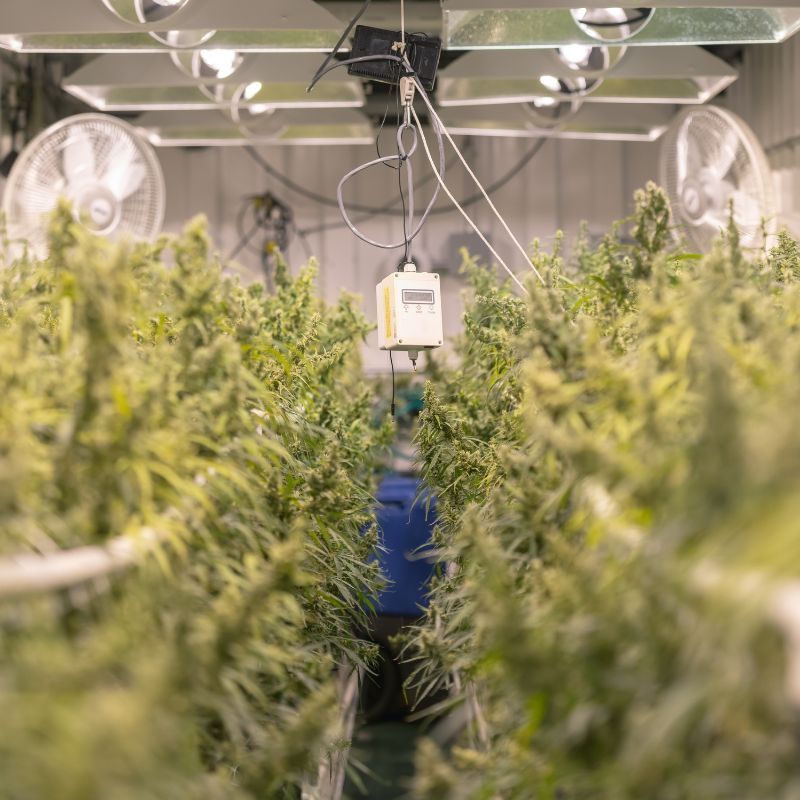Crop Insurance For Cannabis Businesses
See How We're Different
or call us: (215) 653-8411
The cannabis industry has seen exponential growth in recent years, with more states legalizing its use for both medicinal and recreational purposes. As this market expands, so does the need for effective risk management strategies. One of the most crucial aspects of this is crop insurance. This article delves into everything cannabis businesses need to know about crop insurance, including its importance, types available, and how to choose the right policy.
Understanding Crop Insurance
Crop insurance is designed to protect farmers and growers from financial losses due to unforeseen events that can damage their crops. For cannabis businesses, this type of insurance is essential, given the unique challenges they face, including regulatory changes, natural disasters, and pest infestations. As the cannabis industry continues to evolve, the need for a robust insurance framework becomes increasingly critical to ensure sustainability and growth.
The Importance of Crop Insurance for Cannabis Businesses
As the cannabis industry matures, the risks associated with cultivation become more pronounced. Crop insurance serves as a safety net, allowing growers to recover from losses and continue operations. This is particularly important in an industry where the investment can be substantial, and the stakes are high. The financial implications of a crop failure can be devastating, not only affecting the grower’s livelihood but also impacting the broader supply chain, from processors to retailers.
Moreover, having crop insurance can enhance a cannabis business's credibility. Investors and stakeholders often look for assurance that a business has measures in place to mitigate risks. This not only helps in securing funding but also builds trust with customers and partners. In an industry that is still navigating its way through various legal and regulatory landscapes, demonstrating preparedness through insurance can be a significant differentiator in a competitive market.
Types of Crop Insurance
There are several types of crop insurance available, each catering to different needs and circumstances. Understanding these options can help cannabis businesses choose the right coverage for their specific situation. Selecting the appropriate insurance type is crucial, as it can directly impact the financial health and operational continuity of a cannabis operation.
- Actual Production History (APH) Insurance: This type of insurance is based on the historical yield of the crop. It provides coverage based on the average production of the insured crop over a specified period. This method allows growers to establish a reliable baseline for their operations, which can be particularly beneficial for new businesses that may not yet have extensive production histories.
- Revenue Insurance: This insurance protects against loss of revenue due to low prices or reduced yields. It is particularly beneficial for cannabis businesses that may face fluctuating market prices. Given the volatility of cannabis markets, revenue insurance can provide a buffer against sudden price drops, ensuring that growers can maintain their financial stability even in challenging economic conditions.
- Multi-Peril Crop Insurance (MPCI): MPCI covers a range of risks, including natural disasters, pests, and diseases. This comprehensive coverage is ideal for cannabis growers facing multiple threats. With the increasing frequency of extreme weather events, such as droughts and floods, having MPCI can be a vital component of a cannabis business's risk management strategy.
In addition to these standard types of crop insurance, some insurers are beginning to offer specialized products tailored specifically for the cannabis industry. These products may include coverage for specific strains, greenhouse operations, or even
liability coverage related to
product recalls. As the market continues to mature, the development of these niche insurance products will likely play a pivotal role in helping cannabis businesses navigate their unique challenges.
Assessing Risks in Cannabis Cultivation
Before selecting a crop insurance policy, cannabis businesses must assess the specific risks they face. This involves understanding both environmental factors and operational challenges that could impact crop yield and quality. A comprehensive risk assessment not only helps in choosing the right insurance but also informs better management practices that can enhance resilience against potential threats.
Environmental Risks
Cannabis cultivation is susceptible to various environmental risks, including extreme weather conditions such as droughts, floods, and storms. These events can devastate crops and lead to significant financial losses. Additionally, pests and diseases pose a constant threat to cannabis plants, making it crucial for growers to have coverage that addresses these risks. Growers should also consider the impact of climate change, which can alter growing seasons and introduce new pests or diseases previously not encountered in their region. Implementing integrated pest management strategies and investing in climate-resilient practices can further safeguard against these environmental challenges.
Operational Risks
Operational risks can arise from factors such as labor shortages, equipment failures, and supply chain disruptions. In the cannabis industry, where regulations are stringent, any operational hiccup can lead to compliance issues and financial penalties. Crop insurance can help mitigate these risks by providing financial support in case of unforeseen operational challenges. Furthermore, businesses should cultivate strong relationships with suppliers and invest in training programs for employees to ensure a skilled workforce that can adapt to changing demands. Regular maintenance of equipment and contingency planning for supply chain interruptions can also enhance operational stability, allowing growers to focus on producing high-quality cannabis without the looming threat of unexpected setbacks.

Choosing the Right Crop Insurance Policy
With various options available, selecting the right crop insurance policy can be daunting. However, by considering key factors, cannabis businesses can make informed decisions that best suit their needs.
Evaluate Coverage Needs
Understanding the specific coverage needs is the first step in choosing a policy. This involves assessing the types of crops grown, the scale of operations, and the potential risks involved. For instance, a large-scale cannabis farm may require more comprehensive coverage compared to a small operation. Additionally, factors such as the geographical location of the farm can influence the types of risks faced. Regions prone to extreme weather events, pests, or diseases may necessitate specialized coverage options to safeguard against these threats. Furthermore, understanding the growth cycle of cannabis plants can help in determining the right timing for coverage, ensuring that the policy is active during critical growth phases.
Compare Policies and Providers
Once the coverage needs are identified, it's essential to compare different policies and providers. Look for insurers that specialize in agricultural insurance, particularly those with experience in the cannabis sector. Reading reviews and seeking recommendations can also help in finding reputable providers. It’s also beneficial to inquire about the insurer’s claims history and customer service reputation, as these factors can significantly impact the experience during a claim process. Additionally, consider the flexibility of the policy options; some providers may offer customizable plans that can adapt to the evolving needs of a cannabis business, allowing for adjustments in coverage as the operation grows or changes.
Understand Policy Terms and Conditions
Before finalizing a policy, it's vital to thoroughly review the terms and conditions. Pay attention to exclusions, deductibles, and the claims process. Understanding these details can prevent surprises when filing a claim. Additionally, consulting with an insurance broker who specializes in agricultural insurance can provide valuable insights and guidance. Brokers can help clarify complex terminology and ensure that the chosen policy aligns with the unique requirements of the cannabis industry. It’s also wise to stay informed about any changes in regulations that may affect insurance coverage, as the legal landscape surrounding cannabis continues to evolve. Being proactive in understanding these elements can empower cannabis businesses to navigate their insurance needs more effectively.
The Claims Process
Filing a claim can be a complex process, but understanding the steps involved can streamline the experience for cannabis businesses. Knowing what to expect can alleviate stress during challenging times. The cannabis industry, with its unique regulatory challenges and operational intricacies, requires a tailored approach to insurance claims. Being proactive in understanding the claims process can empower business owners to navigate potential hurdles effectively.
Documenting Losses
Accurate documentation is crucial when filing a claim. Cannabis growers should maintain detailed records of their operations, including production levels, financial statements, and any incidents that may have led to losses. Photographic evidence can also support claims, particularly in cases of environmental damage. In addition to standard records, businesses should consider keeping a log of communications with suppliers and vendors, as this can provide context and additional evidence of the operational impact of any losses incurred. Furthermore, utilizing digital tools for inventory management can enhance the accuracy of loss documentation, making it easier to present a comprehensive case to insurers.
Communicating with Insurers
Once losses are documented, the next step is to communicate with the insurance provider. Timely reporting is essential, as most policies have specific deadlines for claims submission. Clear communication about the nature of the loss and the extent of the damage can facilitate a smoother claims process. It is also beneficial to familiarize oneself with the specific claims adjuster assigned to the case, as building rapport can lead to more effective communication. Additionally, preparing a thorough summary of the events leading to the claim can help clarify the situation and expedite the evaluation process, ensuring that all relevant details are conveyed to the insurer.
Understanding Claim Outcomes
After submitting a claim, insurers will assess the situation and determine the payout based on the policy terms. Understanding how claims are evaluated can help cannabis businesses set realistic expectations. If a claim is denied, reviewing the reasons for denial can provide insights for future coverage adjustments. It's also advisable to seek clarification from the insurance provider regarding any ambiguous terms or conditions that may have influenced the decision. Engaging with a claims advocate or legal professional who specializes in cannabis insurance can provide additional support in navigating disputes and ensuring that businesses receive fair treatment in the claims process. This proactive approach not only aids in addressing current claims but also strengthens future risk management strategies.

Regulatory Considerations
The cannabis industry is heavily regulated, and these regulations can impact crop insurance policies. Understanding the legal landscape is essential for cannabis businesses to ensure compliance and protect their investments.
State-Specific Regulations
Each state has its own set of regulations governing cannabis cultivation, which can influence the availability and terms of crop insurance. Cannabis businesses must stay informed about state-specific requirements and how they affect insurance options. Some states may have programs that support agricultural insurance for cannabis growers, while others may impose restrictions. For instance, states like California and Colorado have developed comprehensive frameworks that not only regulate cultivation but also provide avenues for growers to access specialized insurance products. These programs can include subsidies or incentives aimed at mitigating risks associated with crop failure due to pests, disease, or adverse weather conditions.
Federal Regulations
While cannabis is legal in many states, it remains classified as a Schedule I substance under federal law. This creates complexities for insurance providers, as they may be hesitant to offer coverage for cannabis-related operations. Understanding the federal landscape can help cannabis businesses navigate insurance options more effectively. Additionally, the ongoing discussions in Congress regarding the potential rescheduling or decriminalization of cannabis could lead to significant changes in the regulatory framework. Should federal regulations evolve, it could open up a broader market for insurance providers, allowing them to develop more comprehensive policies tailored to the unique needs of the cannabis industry. This shift could also encourage more financial institutions to engage with cannabis businesses, further enhancing their access to necessary resources and support.
Best Practices for Cannabis Growers
Implementing best practices can enhance crop resilience and reduce the likelihood of losses, ultimately benefiting both the business and its insurance coverage.
Invest in Quality Cultivation Techniques
Utilizing high-quality cultivation techniques can significantly impact the health and yield of cannabis crops. This includes investing in proper soil management, pest control, and irrigation systems. Healthy plants are less susceptible to disease and environmental stressors, which can lead to fewer claims and lower insurance costs over time. Moreover, employing organic farming methods can not only improve soil health but also appeal to a growing segment of consumers who prioritize sustainability. Techniques such as crop rotation and companion planting can further enhance biodiversity, creating a more resilient ecosystem that supports the growth of robust cannabis plants.
Stay Informed on Market Trends
Keeping abreast of market trends can help cannabis businesses anticipate challenges and adapt accordingly. Understanding pricing fluctuations and consumer preferences can inform cultivation decisions and risk management strategies. This proactive approach can mitigate potential losses and enhance overall business resilience. Additionally, leveraging data analytics tools can provide insights into consumer behavior and emerging trends, allowing growers to tailor their products to meet market demands. By staying ahead of the curve, businesses can not only optimize their crop selection but also enhance their marketing strategies, ensuring they remain competitive in a rapidly evolving industry.
Engage with Industry Networks
Networking with other cannabis businesses can provide valuable insights and support. Engaging with industry associations and attending conferences can help growers stay informed about best practices, regulatory changes, and insurance options. Building a community can foster collaboration and innovation in the cannabis sector. Furthermore, participating in workshops and seminars can offer hands-on learning experiences that deepen understanding of advanced cultivation techniques and emerging technologies. By sharing knowledge and resources, growers can collectively address challenges such as pest management and climate change, ultimately strengthening the entire industry’s capacity to thrive in a competitive market.
Conclusion
Crop insurance is a vital component of risk management for cannabis businesses. As the industry continues to grow and evolve, understanding the nuances of crop insurance can provide a competitive edge. By assessing risks, choosing the right policies, and implementing best practices, cannabis growers can protect their investments and ensure long-term success.
As the landscape of cannabis cultivation changes, staying informed and adaptable is key. With the right crop insurance in place, cannabis businesses can navigate challenges with confidence, allowing them to focus on what they do best—growing high-quality cannabis products for consumers.

Article By: Deb Sculli
Cannabis Insurance Specialist
Contact Us
FAQS
Common Questions About Crop Insurance For Cannabis Businesses
Answers to the questions we hear most from cannabis business owners.
What is Crop Insurance for Cannabis Businesses?
Crop Insurance for Cannabis Businesses protects growers from financial losses caused by unexpected events like fire, theft, natural disasters, or equipment failure. It ensures that your investment in cultivation is not lost when crops are damaged.
Why do cannabis growers need Crop Insurance for Cannabis Businesses?
Cannabis crops are highly valuable and vulnerable to risks like mold, pests, or extreme weather. Crop Insurance for Cannabis Businesses helps growers safeguard revenue and maintain business stability.
What does Crop Insurance for Cannabis Businesses typically cover?
Crop Insurance for Cannabis Businesses often covers perils such as fire, theft, vandalism, equipment breakdown, and certain weather events. Coverage details vary by policy and insurer.
Who should consider Crop Insurance for Cannabis Businesses?
Any cannabis cultivator, whether indoor, outdoor, or greenhouse, should consider Crop Insurance for Cannabis Businesses. It’s especially critical for businesses with large-scale operations or significant financial exposure.
How much does Crop Insurance for Cannabis Businesses cost?
The cost of Crop Insurance for Cannabis Businesses depends on factors like crop size, growing environment, location, and risk profile. Premiums are usually based on the total insured value of the crop.
Is Crop Insurance for Cannabis Businesses required by law?
No, Crop Insurance for Cannabis Businesses is not legally required. However, many growers choose it to protect their investment and meet lender or investor requirements.
Businesses We Served
Cannabis Businesses We Protect
We served a large variety of cannabis businesses throughout the US













